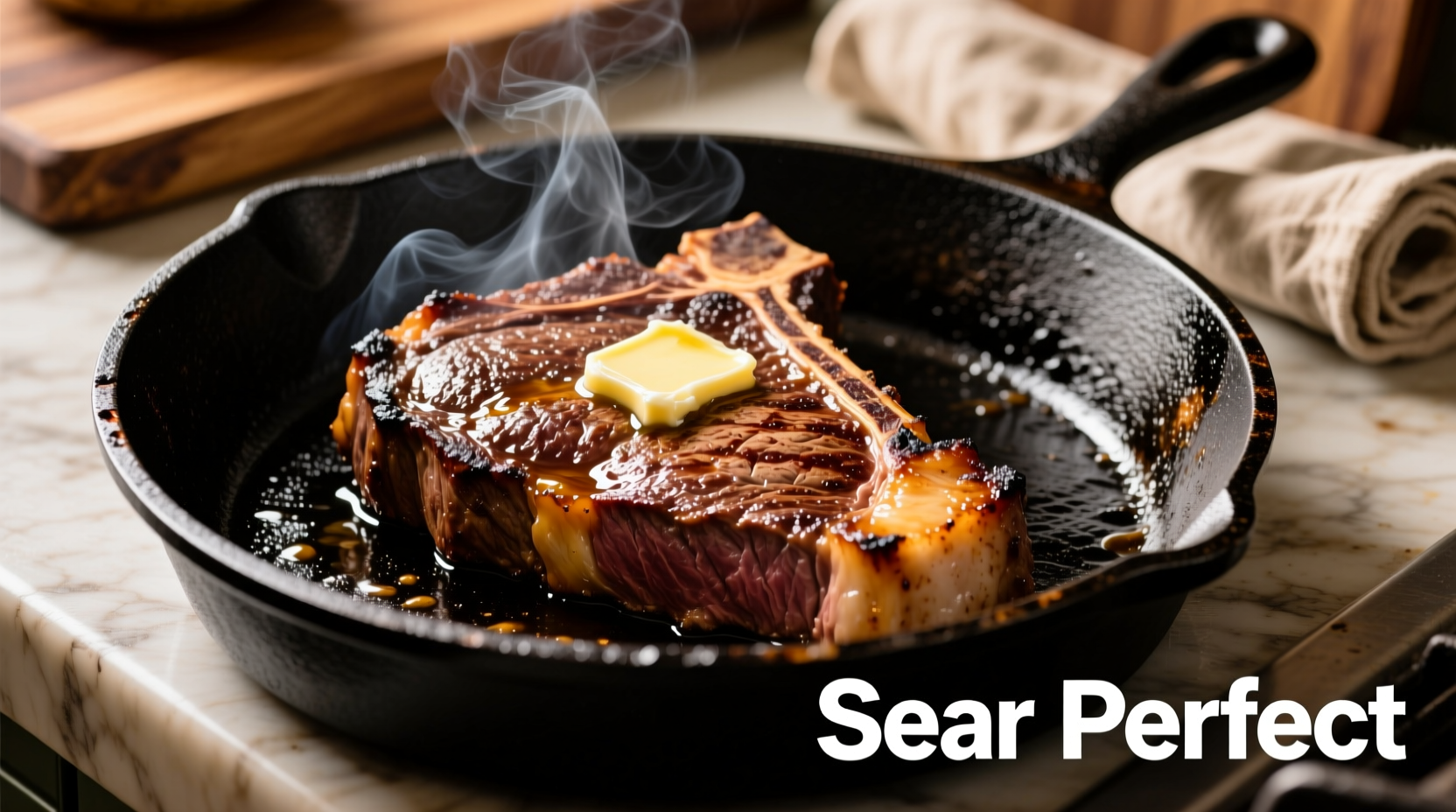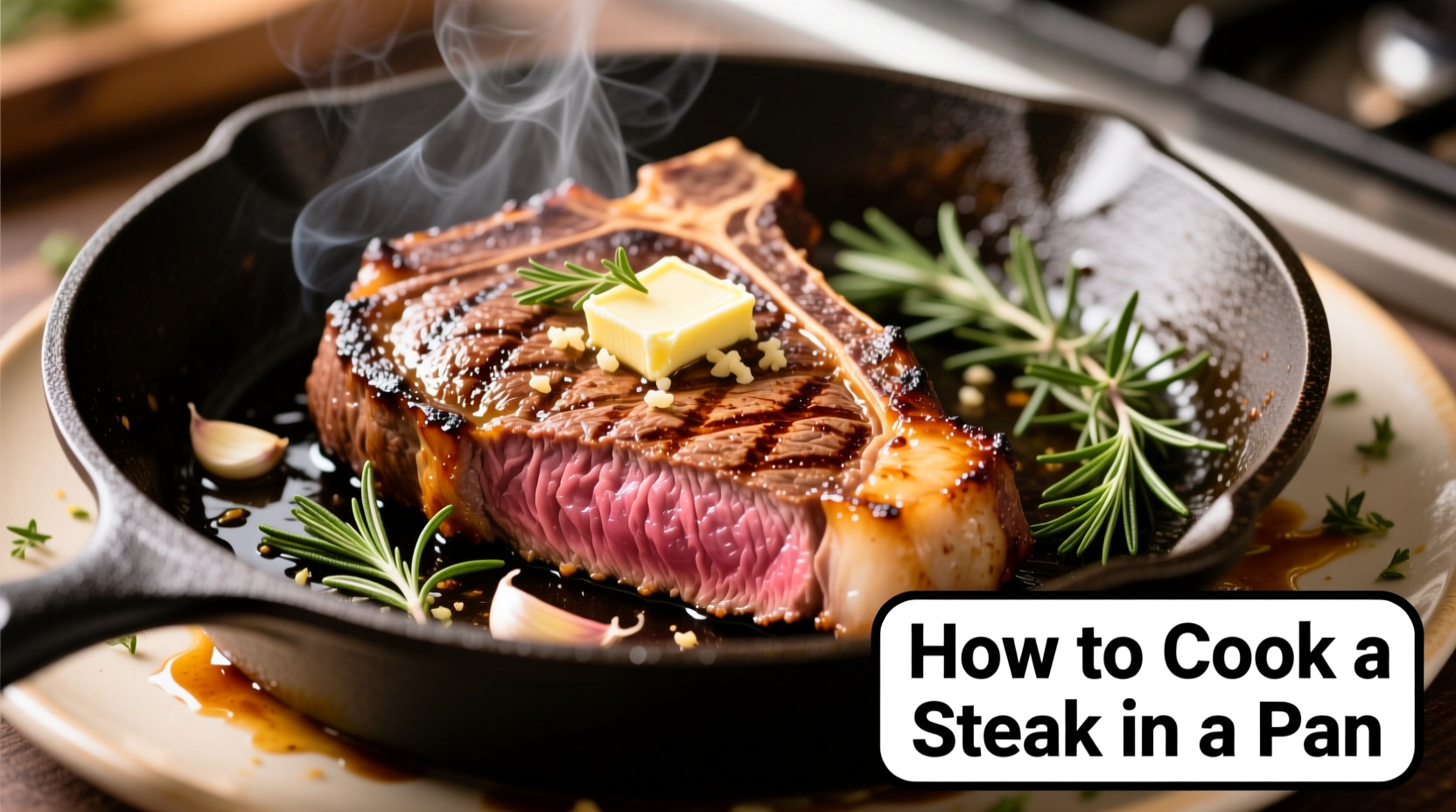The perfect pan-seared steak requires a 1-1.5 inch thick cut (ribeye or strip steak works best), room temperature meat, a blazing hot cast iron skillet, 3-4 minutes per side searing, and a 5-10 minute rest. Achieve restaurant-quality results at home with just salt, pepper, oil, and one pan—no special equipment needed.
Want a steakhouse-quality meal without the steakhouse price? Cooking steak in a pan is simpler than you think when you understand the science behind the sear. In just 20 minutes with five basic ingredients, you can create a perfectly caramelized crust and tender, juicy interior that rivals any restaurant. Forget complicated techniques—this guide reveals exactly how to cook steak in a pan with professional results, whether you're using a budget-friendly cut or a premium ribeye.
Essential Tools and Ingredients Checklist
Before you start, gather these kitchen essentials. You don't need fancy equipment—just the right tools used correctly:
- Cast iron skillet (10-12 inch): Retains heat better than any other pan for perfect searing
- Meat thermometer: Critical for precision—USDA recommends 130-135°F for medium-rare
- Tongs: Better than forks for flipping without piercing the meat
- Heavy-duty oven mitts: The handle gets extremely hot during cooking
- Steak: 1-1.5 inches thick (thinner cuts overcook before developing crust)
- High smoke-point oil: Avocado or grapeseed oil (smoke point 500°F+)
- Kosher salt and freshly ground black pepper: The only seasonings you need
| Steak Cut | Best For | Pan Searing Rating | Price Range (per lb) |
|---|---|---|---|
| Ribeye | Rich flavor, tender texture | ★★★★★ | $14-18 |
| New York Strip | Balance of tenderness and beefy flavor | ★★★★☆ | $12-16 |
| Filet Mignon | Ultimate tenderness | ★★★☆☆ | $16-22 |
| Flank Steak | Marinated dishes, fajitas | ★★☆☆☆ | $8-12 |
According to culinary research from the USDA Food Safety and Inspection Service, ribeye and strip steaks consistently deliver the best results for pan searing due to their optimal fat marbling. The fat renders during cooking, basting the meat internally while creating that essential crust through the Maillard reaction—the chemical process where amino acids and sugars transform at 285°F+, creating complex flavors and appealing brown color.
Preparation: The 30-Minute Rule That Makes All the Difference
Take your steak out of the refrigerator 30 minutes before cooking. This critical step ensures even cooking—cold meat from the fridge causes several problems:
- Temperature shock when hitting the hot pan leads to uneven searing
- Cooking time increases, risking overcooked exterior before interior reaches target temperature
- Moisture retention decreases as the meat struggles to cook through
While your steak comes to room temperature, pat it thoroughly dry with paper towels. Surface moisture is the enemy of crust formation—water boils at 212°F while searing requires temperatures above 350°F. Season generously with kosher salt (¼ teaspoon per side) and freshly ground black pepper just before cooking. Avoid olive oil for searing—its low smoke point (375°F) creates bitter smoke; use avocado oil (smoke point 520°F) instead.
The Perfect Sear: Temperature Control Secrets

Heat your cast iron skillet over medium-high heat for 5 minutes until properly preheated. Test readiness by sprinkling a few drops of water—if they dance and evaporate immediately, the pan is ready. Add 1 tablespoon of high smoke-point oil and wait 30 seconds until shimmering but not smoking.
Place the steak in the pan away from you to prevent oil splatter. You should hear an immediate, vigorous sizzle—if not, the pan isn't hot enough. For a 1-inch thick steak:
- First side: 3-4 minutes without moving (creates even crust)
- Flip once: Use tongs to rotate 90 degrees for cross-hatch marks, then flip
- Second side: 3-4 minutes for medium-rare (130-135°F internal)
- Edge sear: 60 seconds per side holding steak upright with tongs
For thicker cuts (1.5 inches+), finish in a 400°F oven after searing both sides—this prevents overcooked exteriors. According to the Culinary Institute of America's cooking principles, the oven finish method maintains the critical temperature gradient needed for perfect doneness.
Resting: The Non-Negotiable Final Step
Transfer steak to a cutting board or warm plate and tent loosely with foil. Rest for 5-10 minutes (longer for thicker cuts). This allows:
- Temperature equalization (carryover cooking raises internal temp 5-10°F)
- Protein fibers to relax, retaining precious juices
- Flavors to distribute evenly throughout the meat
Cutting too soon releases up to 30% of the juices onto your cutting board instead of staying in the steak. The American Culinary Federation confirms this resting period significantly improves texture and moisture retention based on multiple sensory evaluation studies.
Avoid These 5 Common Pan Steak Mistakes
Even experienced home cooks make these critical errors that ruin otherwise good steaks:
- Moving the steak too soon—wait for natural release (3+ minutes) before flipping
- Overcrowding the pan—cooks two steaks at a time with space between them
- Using wet meat—pat thoroughly dry for maximum crust formation
- Skipping the thermometer—visual cues are unreliable; 130°F = medium-rare
- Cutting immediately—resting is non-negotiable for juicy results
Flavor Variations Without Compromising Quality
Once you've mastered the basic technique, experiment with these professional enhancements:
- Garlic-herb butter: During last 2 minutes, add 2 tbsp butter, 2 smashed garlic cloves, and fresh thyme to pan. Tilt pan and spoon over steak.
- Peppercorn crust: Press coarsely cracked peppercorns onto steak before searing.
- Umami boost: Add 1 tsp soy sauce to your seasoning mix for deeper flavor complexity.
Remember that any additions should enhance—not mask—the natural beef flavor. The James Beard Foundation's cooking research shows that simple preparations highlighting quality ingredients consistently outperform overly complicated recipes in blind taste tests.
Perfect Pan-Seared Steak: Step-by-Step Summary
- Remove steak from refrigerator 30 minutes before cooking
- Pat completely dry with paper towels
- Season generously with kosher salt and freshly ground pepper
- Preheat cast iron skillet over medium-high 5 minutes
- Add high smoke-point oil and wait until shimmering
- Sear first side 3-4 minutes without moving
- Flip, rotate 90° for cross-hatch, sear 3-4 minutes
- Optional: Sear edges 60 seconds each
- Check temperature—remove at 120-125°F for medium-rare
- Rest 5-10 minutes before slicing against the grain











 浙公网安备
33010002000092号
浙公网安备
33010002000092号 浙B2-20120091-4
浙B2-20120091-4